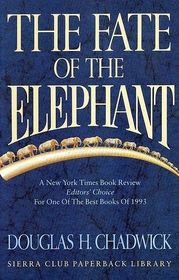Search -
The Fate of the Elephant
The Fate of the Elephant
Author:
The elephant, the largest, most powerful, and one of the smartest creatures to walk the planet. They have the power to communicate in a language of subsonic frequencies, snorkel across the open sea between islands, care for their wounded and mourn their dead. Asian elephants were domesticated more than 4,000 years ago and, like their African cou... more »
Author:
The elephant, the largest, most powerful, and one of the smartest creatures to walk the planet. They have the power to communicate in a language of subsonic frequencies, snorkel across the open sea between islands, care for their wounded and mourn their dead. Asian elephants were domesticated more than 4,000 years ago and, like their African cou... more »
ISBN-13: 9780871564955
ISBN-10: 0871564955
Publication Date: 5/1/1994
Pages: 492
Rating: 1
ISBN-10: 0871564955
Publication Date: 5/1/1994
Pages: 492
Rating: 1
3 stars, based on 1 rating
Publisher: Sierra Club Books for Children
Book Type: Paperback
Other Versions: Hardcover
Reviews: Amazon | Write a Review
Book Type: Paperback
Other Versions: Hardcover
Reviews: Amazon | Write a Review
Genres:
- Science & Math >> Biological Sciences >> Animals >> Mammals
- Outdoors & Nature >> Conservation >> Endangered Species
- Outdoors & Nature >> Conservation >> Wildlife
- Outdoors & Nature >> Field Guides >> Mammals





